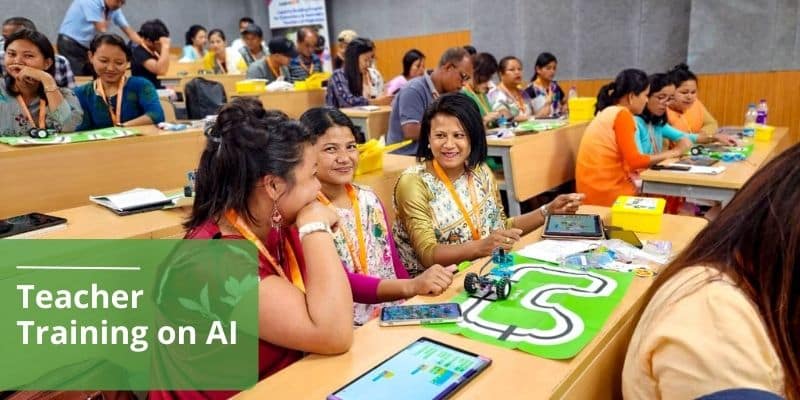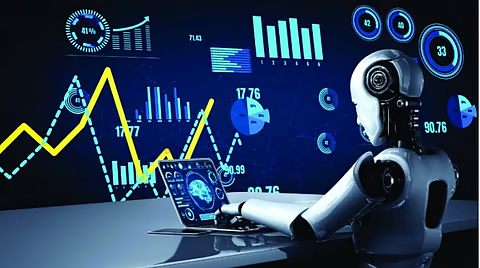In 2025, artificial intelligence (AI) is reshaping education across the globe in profound ways. From personalised learning paths to immersive virtual experiences, AI isn’t just a trend—it’s becoming an essential part of teaching and learning. Here’s an exploration into how AI technology trends in education in 2025 are transforming classrooms, empowering teachers, and preparing students for tomorrow.
AI as the Teacher’s New Best Friend
Imagine a classroom where teachers have not one, but several helpful assistants—smart, diligent, and always on call. That’s exactly how Sal Khan, CEO of Khan Academy, sees the future. In a recent BBC interview, he compared AI assistants to “five amazing graduate students” in each class. These aren’t to replace human educators, but to support them by handling grading, monitoring student progress, offering lesson ideas, and providing real-time feedback to both teachers and parents
This shift is significant, especially amid widespread teacher shortages and burnout. AI could help lighten workloads, enabling teachers to focus on building student relationships, guiding social skills, and creating a richer learning experience.
Teachers Embrace AI to Reclaim Time and Spark Creativity
A recent AP News feature highlights how educators are actively using AI tools like ChatGPT to reclaim hours each week, sometimes saving up to six hours of admin work. Teachers Ana Sepúlveda and Mary McCarthy describe how AI supports lesson planning, grading, and student engagement. However, they emphasise that AI technology should serve as a supplement—not a crutch—to preserve students’ critical thinking and problem-solving abilities.
As districts roll out AI training and ethical guidance, educators are learning to weave technology into teaching while ensuring human judgment remains central.

Personalised Learning Powered by AI
One of the most transformative trends in 2025 is ultra-personalised learning. AI systems sift through student data—quizzes, homework, even preference trends—to customise lessons in real time. Companies like DreamBox, Knewton, and Squirrel AI are leading the charge, helping students learn at their own pace, filling knowledge gaps or advancing ahead when ready.
Real-time feedback is a core feature: students receive tailored help immediately, while teachers gain insights into student needs, without drowning in grading.
AI Tutors and Chatbots: 24/7 Learning Support
Students don’t stick to a 9-to-3 schedule, and AI tutors understand that. Intelligent tutoring systems (ITS) and chatbots are now available around the clock, offering instant help and adaptive support.
Platforms like eSelf AI respond in under two seconds, guiding learners through subjects ranging from history to programming narayanaschools.in+13eself.ai+13reddit.com+13. Pilot studies, such as one in Nigeria, reveal that after-school AI tutoring can deliver learning gains equal to two years of traditional teaching in just six weeks, especially boosting outcomes for girls.
Smarter, Fairer Grading and Feedback
No more waiting for grades. AI technology is grading essays, checking for plagiarism, and offering insightful feedback, fast and objectively. Tools like Gradescope and Turnitin already help detect writing issues, while some systems analyse error patterns to pinpoint concept gaps.
Studies show AI grading aligns with human grading about 85–95% of the time, speeding up the process and freeing teachers to focus on mentoring and class interaction numberanalytics.com.

Immersive Learning: VR, AR & XR Powered by AI
In 2025, immersive tech—Virtual Reality (VR), Augmented Reality (AR), and Mixed Reality (XR)—is becoming a staple in classrooms. With entry-level headsets priced around $299, schools are embedding immersive experiences into lessons.
Imagine a student walking through ancient Rome or dissecting virtual frogs, with AI tracking their performance and adjusting challenges instantly. VR-trained learners show 275% more confidence applying new skills compared to traditional teaching.
Predictive Learning Analytics: Seeing Trouble Before It Hits
Between 45% and 67% of schools are now using AI data analytics to detect learning hurdles early. These systems analyse attendance, participation, quiz scores, and other performance metrics to forecast which students might struggle.
For example, Georgia State University boosted graduation rates by 23% after implementing predictive analytics that flagged at-risk students early. This trend allows educators to intervene before small issues become big setbacks.
AI for Equity & Accessibility
AI’s power extends to closing educational divides. From real-time translation and text-to-speech to tailored learning support, AI technology empowers multilingual learners and students with disabilities.
In regions with limited teacher access, AI tutors are levelling the playing field. By 2025, AI technology could support quality learning in remote or underserved communities. But schools must also address bias in datasets and accessibility challenges.
Stronger Ethical & Privacy Safeguards
Handling sensitive student data calls for robust ethical standards. With AI systems gathering behavioural metrics, attendance, and even biometric data, protecting privacy is critical.
Policymakers and schools are drafting AI usage guidelines, such as Charlotte‑Mecklenburg Schools, which will publish standards for AI in classrooms by August 2025. Teacher training is also expanding: a recent poll showed 87% of educators had never received formal AI training, highlighting the urgent need for teacher preparation.
Teacher AI Training & Professional Growth
Abu Dhabi’s ‘AI for Teachers’ program offers a promising template—educators undergo a structured three-phase curriculum, hands-on workshops, and a capstone project, with overwhelmingly positive feedback from participants.
Ohio State University now requires all new undergraduates to complete “AI Fluency” training, integrating AI education across all majors. Telangana University of Technology and Design also launched AI/design courses backed by a $50 million investment to help educators and students adapt to a tech-driven world.

Hybrid, Online & Microlearning Gains Momentum
Hybrid and online learning have matured. In 2025, over half of higher-ed institutions plan to expand hybrid options, with interactive whiteboards, skill labs, and asynchronous content becoming standard.
Microlearning—short, focused lessons—retains attention and boosts retention. Studies show it improves recall by 20% over longer formats.
Gamified Learning & Edutainment
Education is getting fun. Gamification adds engaging elements—points, badges, storylines—while AI-driven simulations bring content to life
Tools like Minecraft Education and AI-generated quests help students explore Shakespeare or ecosystems in interactive ways. Gamified learning can boost motivation, but it must be balanced to retain educational substance.
AI in Higher Education Administration & Research
AI isn’t just for K–12—it’s reshaping universities too. Admissions offices use AI to process applications, predict enrollment, and flag scholarship candidates.
Research teams use AI tools like Iris.ai and Semantic Scholar to sift through papers, detect patterns, and accelerate discoveries. This enables smart administration and data-driven decision-making across campuses.
Policy Initiatives & Regional Leadership
Governments and school districts are stepping up. The White House launched initiatives for AI literacy and teacher training by fall 2025 kiplinger.com.
Ohio’s AI in Education Coalition is guiding K–12 integration. In Andhra Pradesh, India, universities are launching quantum-AI curricula, preparing students for the jobs of tomorrow.
What Students, Teachers, and Parents Should Know
- Students: You’ll find AI tutors, immersive lessons, and personalised learning. Stay curious, but keep critical thinking sharp.
- Educators: Embrace AI as a teammate, not a threat. Focus on training, ethics, and leveraging AI to enhance your teaching.
- Parents: Expect richer feedback loops and deeper insights into your child’s learning journey, but ask about data privacy and responsible use first.
Looking Ahead: What 2025 Brings—and What Beyond?
AI technology trends in education 2025 are driving a transformation—from rote memorisation to dynamic, data-driven classrooms. Teachers are no longer overwhelmed with administrative work; students are learning in immersive, personalised environments; and education is becoming more inclusive.
But this journey is just beginning. To ensure success:
- Invest in teacher training so every educator can use AI safely and effectively.
- Prioritise ethics and transparent data use.
- Fund infrastructure—devices, headsets, and reliable internet access.
- Ensure equitable access so no student is left behind.
With these in place, the classroom of 2025 is set to be a place of innovation, creativity, and human connection—enhanced, not replaced, by intelligent technology.
In Summary
The headline is clear: AI technology trends in education 2025 are revolutionizing learning. From automated grading to immersive VR classrooms, adaptive tutoring to robust analytics, AI is becoming a trusted ally for students and teachers. But as we embrace innovation, we must safeguard privacy, invest in people, and ensure equity for all.
Join Our Social Media Channels:
WhatsApp: NaijaEyes
Facebook: NaijaEyes
Twitter: NaijaEyes
Instagram: NaijaEyes
TikTok: NaijaEyes








































